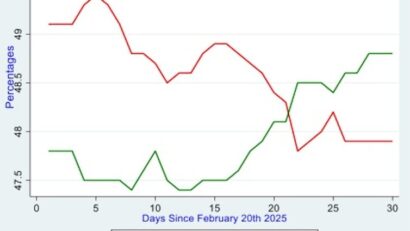
Three graphs that show what’s happening with Donald Trump’s popularity
Donald Trump started out with more Americans approving than disapproving of his performance just after inauguration day on January 20 , and this continued into February. By early March, his ratings had turned a little bit negative, but not by much, and it has stayed that way. As of March 20, 48% of Americans approved of his job performance so far, while 49% disapproved.
The daily average of polls measuring approval/disapproval ratings for the job Trump is doing appears in the chart below. They cover the period from February 20 to March 20.
Approval and disapproval ratings for Trump’s performance:
RealClearPolling, Author provided (no reuse)
These aggregate ratings are interesting, but they disguise the political divide which is revealed when we drill down into the details. This can be done using an Economist/YouGov poll completed on March 18, for instance.
This reveals how polarised American public opinion has become when it comes to judging the president. Around 6% of respondents who identified themselves as Democrats approved of his performance, while 93% of them disapproved. Those who identified as Republican were almost the exact opposite, with 90% approving and 7% disapproving.
One problem in analysing these statistics is that only 29% of the sample interviewed were Republicans, compared with 34% Democrats. The pollsters do their best to get a representative sample of the US electorate and it’s worth noting that there are currently more registered Democrats in the US than there are Republicans.
Interestingly, the American National Election Study survey conducted just before the presidential election last year showed that only 11.6% of Americans were supporters of the Maga movement. This highly respected study, which has been carried out over the past 75 years as a national resource, would suggest that Maga supporters are noisy, but fewer in number than some people might realise.
What do independents think?
Around 37% of those interviewed for the Economist poll described themselves as independents. In their case 37% of them approved of his performance and 54% disapproved. Trump may have a very strong following among Republicans, but they are less than one-third of the electorate.
A quick calculation looking at support among Democrats, Republicans and independents in proportion to their size in the electorate suggests that 42% of Americans have a favourable view of his performance, while 54% have an unfavourable view.
If we look at the social backgrounds of respondents in the survey there is not much difference between the young and the old, or different income groups in their attitudes to the president’s performance. But there is a large gender gap with 53% of men, but only 39% of women, approving. Similarly, while 53% of whites approved, only 24% of blacks and 31% of Hispanics did so. Finally, 7% of ideological liberals approved of Trump’s job performance, compared with 81% of conservatives and 44% of moderates. Overall, partisanship and ideology completely dominate the picture when it comes to judging Trump’s record.
How important is the economy?
US politics is in turmoil with large federal jobs losses and significant changes, such as tariffs on Canadian goods, being announced by the new administration, so there are a lot of factors at work which can explain attitudes to Trump. In the 2024 presidential election the economy played a key role in explaining how people voted, and it is always an important issue in elections.
Given that, it is interesting to look at one of the key measures of the voter’s attitudes to the economy, namely consumer confidence. This has been measured by researchers at the University of Michigan for many decades using a series of surveys conducted every month.
US consumer sentiment scale March 2024 to March 2025:
University of Michigan, Author provided (no reuse)
The chart shows scores on the Index of Consumer Sentiment from March of last year until March this year. A high score means Americans are confident about the state of their economy and a low score the opposite. Confidence has plunged from a rating of 79.4 a year ago to 57.9 now. It is notable that, as recently as December 2024, it stood at 74.0, but after the inauguration of Trump it started to rapidly decline. Americans are getting increasingly worried about the state of their economy, along with the rest of the world.
The cause is not hard to discern: the imposition of tariffs, a fall in the stock market, the threat of inflation, the administration’s sympathy towards Vladimir Putin and its threats to allies such as Canada and Greenland over their territorial integrity. These issues are all adding up to a self-imposed economic crisis.
But what are the implication of this for presidential approval ratings? The chart below shows the relationship between consumer confidence and presidential approval over a period of nearly 50 years. There is a moderately strong relationship between the two series (correlation = 0.40). When consumers are optimistic, they approve of the president’s performance, and when they are pessimistic, they disapprove.
Presidential approval and consumer confidence 1978-2025:
University of Michigan, Author provided (no reuse)
Overall, the data suggests that Trump should not be confident of his approval ratings across the US, if you look at people across all political affiliations and who vote. Along with a looming economic crisis, this could lead to a rapid loss of support for the president and the Republicans in the near future. Läs mer…

